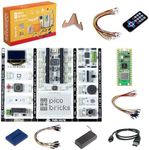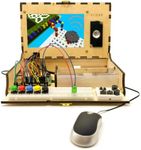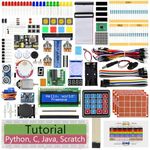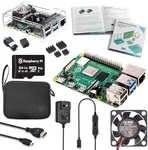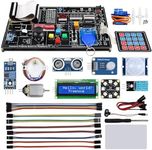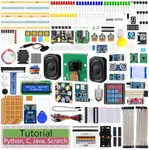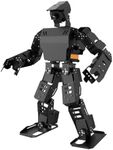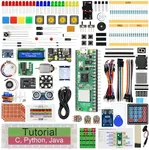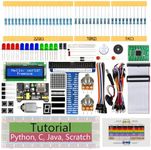Buying Guide for the Best Raspberry Pi Starter Kit For Kids
Choosing a Raspberry Pi starter kit for kids can be a fun and educational experience. Raspberry Pi is a small, affordable computer that can be used to learn programming, build projects, and explore technology. When selecting a starter kit, it's important to consider the components included, ease of use, and the educational resources provided. This guide will help you understand the key specifications to look for and how to choose the best kit for your child's needs.Raspberry Pi ModelThe Raspberry Pi model is the core of the starter kit. It determines the processing power, memory, and connectivity options. For kids, a Raspberry Pi 4 or Raspberry Pi 400 is recommended due to their better performance and ease of use. The Raspberry Pi 4 comes in different RAM options (2GB, 4GB, 8GB), with higher RAM providing better multitasking capabilities. The Raspberry Pi 400 is a keyboard-integrated model, making it more user-friendly for beginners. Choose a model that balances performance and ease of use for your child's projects.
Power SupplyA reliable power supply is crucial for the stable operation of the Raspberry Pi. The power supply should match the requirements of the Raspberry Pi model you choose. For example, the Raspberry Pi 4 typically requires a 5V 3A power supply. Ensure the kit includes a compatible power supply to avoid any power-related issues. A good power supply ensures that the Raspberry Pi runs smoothly without unexpected shutdowns.
MicroSD CardThe microSD card acts as the storage for the Raspberry Pi, holding the operating system and any files or programs. The capacity and speed of the microSD card are important. A card with at least 16GB of storage is recommended, but 32GB or more is better for more complex projects. Look for a Class 10 or UHS-1 card for faster read/write speeds, which will improve the overall performance. A pre-installed operating system on the microSD card can make setup easier for kids.
CaseA case protects the Raspberry Pi from physical damage and dust. It also helps with heat dissipation. Cases come in various designs, from simple plastic enclosures to more elaborate ones with built-in fans or heatsinks. For kids, a durable and easy-to-assemble case is ideal. Some cases are designed to be more visually appealing or themed, which can make the learning experience more enjoyable. Choose a case that provides adequate protection and cooling for the Raspberry Pi.
Cables and AdaptersCables and adapters are necessary to connect the Raspberry Pi to other devices, such as monitors, keyboards, and mice. Common cables include HDMI cables for video output and USB cables for peripherals. Ensure the kit includes all the necessary cables and adapters to avoid additional purchases. For kids, having all the required cables in the kit simplifies the setup process and ensures they can start using the Raspberry Pi right away.
Educational ResourcesEducational resources are essential for helping kids learn how to use the Raspberry Pi and develop their programming skills. These resources can include printed guides, online tutorials, and project ideas. Kits that come with comprehensive and age-appropriate educational materials are highly beneficial. Look for kits that offer step-by-step instructions and engaging projects that match your child's interests and skill level. Good educational resources can make the learning process more enjoyable and effective.
Additional ComponentsSome starter kits include additional components like sensors, LEDs, and breadboards for building electronic projects. These components can enhance the learning experience by allowing kids to experiment with hardware and create interactive projects. If your child is interested in electronics and hands-on projects, look for a kit that includes a variety of components. This can provide a more comprehensive learning experience and encourage creativity and problem-solving skills.
